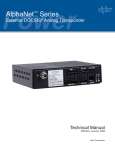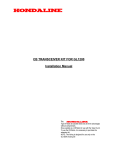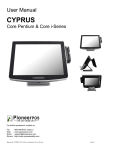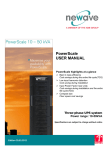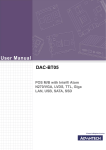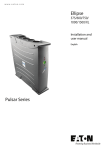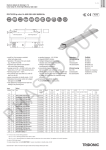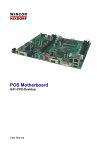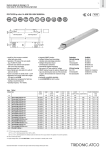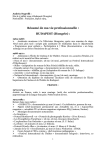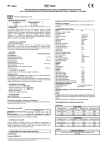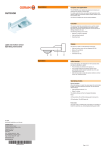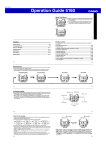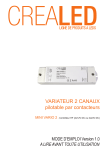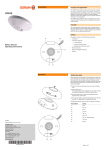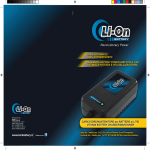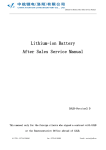Download SC-30 MPPT User Manual - OPTI
Transcript
SC-30 MPPT User Manual ELECTRICAL SPECIFICATIONS Efficiency typical Input voltage 96% 16V to 95V Output voltage Float 13.5V / 27V / 54V Absorption - Vented LA Batteries 14.5V / 29V / 58V Sealed - LA Batteries 14.2V / 28.4V / 56.8V Output power 1700W / 30A MAX Quiescent current 0.05A Thermal protection Multilevel Type Dimensions (mm) 241(L) X 186.8(W) X 69.8(H) mm Indications LED display – OUTPUT STATUS Important: Use only PV systems with open circuit voltage below 95V and a minimum VMP of 18V for 12V batteries, 36V for 24V Batteries and 72V for 48V batteries. Use only sealed or vented 12V, 24V or 48V lead acid batteries and confirm the MPPT settings, charge voltages and currents are correct for your battery system – if in any doubt seek qualified advice! This equipment must be installed by qualified personnel only and incorrect wiring can cause fire, injury or death – OPTI will accept no responsibility for MPPT misconnection or misuse. Use wires suitable for at least 40A, but if wire runs are over 3m then larger wires are recommended to limit voltage drop and losses. Install the unit in a dry place out of direct sunlight and away from flammable liquids or gases. Battery fuse ( BF ) is always required and must be located as close to the battery as possible, its sizing depends on the wire size and load ratings. Typically a 40A 60VDC fuse would do. The lowest Maximum Power Point system voltages are 18V for 12V batteries, 36V for 24V batteries and 72V for 48V batteries to ensure full power. Note: This unit can be directly power (without a battery) a 12VDC motor or pump of up to 150W. General Information: Green LED On – Battery Ok. Green LED Flashing – Battery Low. This MPPT is designed to auto detect 12V, 24V or 48V battery systems and select a suitable charge regime. The MPPT 30-2 is shipped in a sealed battery setting which is the safest setting but if your batteries are vented then, BEFORE wiring the MPPT in, check the BATTERY TYPE SETTING . The maximum absorption voltage is 14.5V, 29V or 58V and the float voltage is 13.5V, 27V or 54V for 12V, 24V or 48V batteries respectively. The absorption phase is entered following a low battery condition or dawn and is maintained until the battery demand falls below 1.5A. This MPPT has a built in multilevel over temperature protection to improve product reliability while maximising output power availability. The maximum continuous output power is 1700W in 48V systems, 850W in 24V systems and 425W in 12V systems. The output current is limited to 30A. BASIC WIRING OPTIONS: Permanent Load Connection: Simplest wiring option where the load is permanently connected and the batteries are not protected from overdischarge. Wiring With Low Voltage Disconnect: This option protects the battery from overdischarge by disconnecting the load. The LVD option disconnects the load when the battery voltage drops below 0.85 of nominal voltage to protect the battery from damage. The load reconnects when the battery voltage exceeds 0.95 of nominal voltage. This feature will not trigger during short transients. LVD load is 30A continuous or 50A transient. Wiring With Critical And Non Critical Loads: Critical loads are generally light loads which are powered under any condition. Non critical loads are loads which can be disconnected to ensure maximum on time for critical loads as well as to extend the life expectancy and reliability of the system. The non critical load can be set up as LVD or Dawn to Dusk loads. Wiring with MCM option: Connecting the optional MCM to the MPPT will allow various system parameter display, output voltage and alarm settings and enable the programmable dawn to dusk or remote load control options. For more details please refer to MCM Manual. For optimal performance from panel and MPPT please use the following table to determine the best setup for your situation. Panel Configuration 1x12V Battery Panel 2x12V Battery Panel 3x12V Battery Panel 4x12V Battery Panel 1x24V Battery Panel 2x24V Battery Panel 21 42 63 84 42 84 16 32 48 64 32 64 1x18 Cell Grid 10 8 1x48 Cell Grid 2x48 Cell Grid 3x48 Cell Grid 1x52 Cell Grid 2x52 Cell Grid 3x52 Cell Grid 1x54 Cell Grid 2x54 Cell Grid 3x54 Cell Grid 1x60 Cell Grid 2x60 Cell Grid 1x72 Cell Grid 2x72 Cell Grid 28 56 84 31 62 93 32 64 96 36 72 44 88 23 46 69 25 50 75 26 52 78 29 58 36 72 1x96cgsp 65 55 Grid Connect Panel (size = no. cells in grid) Battery Type Setting (Above): Sealed Battery Setting (Above): Vented Battery Setting MPPT FAQs Q: What is an MPPT? MPPT stands for Maximum Power Point Tracker and is a specialized converter designed to maintain the PV voltage at the level in which it delivers maximum power to the load or battery. The panel’s nominal output power can only be obtained with the use of an MPPT. Q: What are the GSL MPPTs advantages compared to standard solar regulators? 1. Suitable for new lower cost high efficiency grid type panels since the GSL MPPT can efficiently charge the batteries from relatively high voltage, say 12V batteries from 36V MPP panels. 2. Less interference and more accurate voltages during absorption and float. Q: What happens at low PV currents? The MPPT will outperform the conventional regulator above 3% of nominal panel power. Below 3%, about 10W in a 400W panel, the MPPT will have a slightly lower output current than a non MPPT. Q: Why are MPPT not more common in standalone solar systems? Until now and despite their overwhelming advantages MPPTs have not been commonly used in standalone solar systems because of cost. The new GSL MPPT specifically addresses this issue making economic sense in a wide range of solar systems. Q: What sort of batteries should I use? 1. A deep cycle battery is a must due to the cyclical nature of the solar system with a recommended battery capacity of at least 180AH. 2. A larger battery will not only give longer run time during low light but also will be able to avoid available PV power being unstored such as when battery reaches the float stage. Q: How do PV temperatures affects charge current? Temperature increase brings down the PVs maximum power point voltage reducing the MPPTs current gain available. In principle at 25C it is possible to achieve 30% gain but at 40C, a more realistic average temperature, about 20% is still available. Q: What sorts of loads can I power with the SC-30 MPPT? 1. The maximum bulk charge current with the SC-30 MPPT on a 12V battery and 400W panel is approximately 30A, so you can expect about 100AH per day which means a 100W load for about 10 hours daily. 2. Following the same reasoning with a 24V 800W panel the SC-30 MPPT will supply a daily load of 200W for about 10 hours. 3. Following the same reasoning with a 48V 1600W panel the SC-30 MPPT will supply a daily load of 400W for about 10 hours. Q: Is interference possible? and If so what do I do? MPPTs produce far less interference than conventional solar regulator during the absorption and float stages, that is during most of its operating time, and its designed to comply with local and international EMI standards however some interference is still possible. If interference occurs first try and reorient the aerial or move the sensitive equipment away from the MPPT wires. Ensure the MPPT chassis is grounded. Grounding a battery terminal may also help and finally you can try adding ferrite clamps. MECHANICAL SPECIFICATIONS ◎Drawing & Dimensions:











